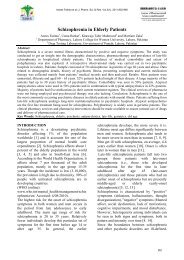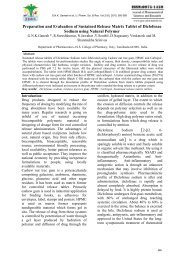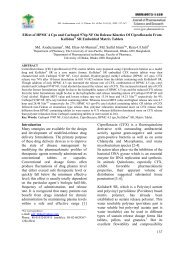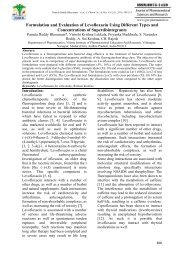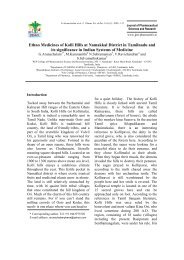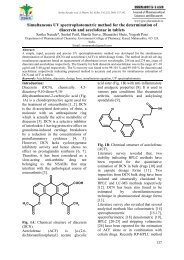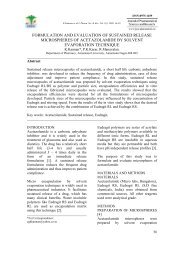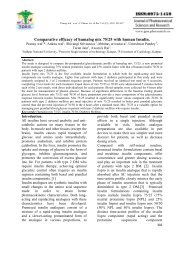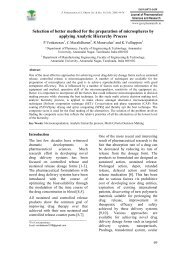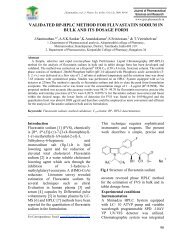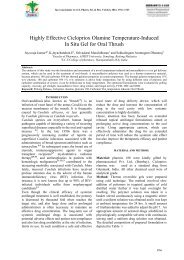Pharmacognostic and Preliminary Phytochemical Investigations on ...
Pharmacognostic and Preliminary Phytochemical Investigations on ...
Pharmacognostic and Preliminary Phytochemical Investigations on ...
Create successful ePaper yourself
Turn your PDF publications into a flip-book with our unique Google optimized e-Paper software.
C.A.Suresh Kumar et al /J. Pharm. Sci. & Res. Vol.1(3), 2009, 129-136.<br />
<str<strong>on</strong>g>Pharmacognostic</str<strong>on</strong>g> <str<strong>on</strong>g>and</str<strong>on</strong>g> <str<strong>on</strong>g>Preliminary</str<strong>on</strong>g> <str<strong>on</strong>g>Phytochemical</str<strong>on</strong>g> <str<strong>on</strong>g>Investigati<strong>on</strong>s</str<strong>on</strong>g> <strong>on</strong> the stem<br />
of Saccharum sp<strong>on</strong>taneum<br />
C.A.Suresh kumar *1 , R.Varadharajan 4 , P.Muthumani 1 , R. Meera 1 ,<br />
P.Devi 2 , B.Kameswari 3<br />
1 Department of Pharmaceutical Chemistry, 2 Department of Pharmacognosy, 3 Department of Biochemistry,<br />
K.M. College of Pharmacy, Uthangudi, Madurai – 625 107.<br />
4 Department of Pharmaceutical Chemistry, Kamalakshi P<str<strong>on</strong>g>and</str<strong>on</strong>g>urangan College of pharmacy TamilNadu, India.<br />
Abstract<br />
The genus “Saccharum” includes about 150 species under the family “Poaceae”. This occurs throughout India al<strong>on</strong>g<br />
the sides of the river <str<strong>on</strong>g>and</str<strong>on</strong>g> tropics of old world, it is widely distributed in Andhra Pradesh, Vellore district in<br />
Tamilnadu. Scientific informati<strong>on</strong> <strong>on</strong> their pharmacognosy, Phytochemistry <str<strong>on</strong>g>and</str<strong>on</strong>g> pharmacology are very scant. Hence<br />
the current study describes some pharmacognostical <str<strong>on</strong>g>and</str<strong>on</strong>g> preliminary phytochemical investigati<strong>on</strong>s undertaken <strong>on</strong> the<br />
stem of <strong>on</strong>e of those species namely Saccharum sp<strong>on</strong>taneum. The samples for research were collected from Vellore,<br />
Tamil Nadu, India <str<strong>on</strong>g>and</str<strong>on</strong>g> authentificated by Dr.P.Jayaraman Ph.D., a director of plant Anatomy Research Centre, <str<strong>on</strong>g>and</str<strong>on</strong>g><br />
then subjected for morphological, microscopical <str<strong>on</strong>g>and</str<strong>on</strong>g> physicochemical analysis. The parameters from the above were<br />
recorded with an objective of drawing an attenti<strong>on</strong> <strong>on</strong> those populati<strong>on</strong>s as well as a reference for further scientific<br />
investigati<strong>on</strong>s.<br />
Keywords: Saccharum sp<strong>on</strong>taneum, Poaceae, Pharmacognosy, <str<strong>on</strong>g>Preliminary</str<strong>on</strong>g> phytochemical.<br />
Introducti<strong>on</strong><br />
Saccharum sp<strong>on</strong>taneum Linn.; Syn<strong>on</strong>yms,<br />
Ahlek, loa, wild cane, wild sugar cane,<br />
Family: Poaceae. This occurs throughout<br />
India al<strong>on</strong>g the sides of the river <str<strong>on</strong>g>and</str<strong>on</strong>g> tropics<br />
of old world, it is widely distributed in<br />
Andhra Pradesh, Vellore district in<br />
Tamilnadu.It grows as waste l<str<strong>on</strong>g>and</str<strong>on</strong>g> weed. It is<br />
c<strong>on</strong>sidered as valuable medicinal herb in<br />
traditi<strong>on</strong>al systems of medicine in India. It is<br />
popular folk medicine. The rural people in<br />
Vellore district of Tamilnadu <str<strong>on</strong>g>and</str<strong>on</strong>g> Andhra<br />
Pradesh are used fresh juice of the stem of<br />
Saccharum sp<strong>on</strong>taneum plant to the<br />
treatment of mental illness <str<strong>on</strong>g>and</str<strong>on</strong>g> mental<br />
disturbances by the vaidhiyars. For this all<br />
reas<strong>on</strong>s we take a plant to bring out an<br />
official manner by the through investigati<strong>on</strong><br />
<strong>on</strong> this plant such as pharmacognostical,<br />
phytochemical <str<strong>on</strong>g>and</str<strong>on</strong>g> psychopharmacological<br />
studies the stem of Saccharum sp<strong>on</strong>taneum<br />
Linn. The whole plant according to siddha<br />
the whole plant used to diseases of vatam<br />
<str<strong>on</strong>g>and</str<strong>on</strong>g> pittam, vomiting, mental diseases,<br />
abdominal disorders, dyspnoea, anaemia,<br />
<str<strong>on</strong>g>and</str<strong>on</strong>g> obesity. The root according to ayurveda<br />
roots are sweet, astringent, emollient,<br />
refrigerant, diuretic, lithotriptic, purgative,<br />
t<strong>on</strong>ic, aphrodisiac <str<strong>on</strong>g>and</str<strong>on</strong>g> useful in treatment of<br />
dyspepsia, burning sensati<strong>on</strong>, piles, sexual<br />
weakness, gynecological troubles,<br />
respiratory troubles etc. The stems (culm)<br />
are useful in vitiated c<strong>on</strong>diti<strong>on</strong>s of pitta <str<strong>on</strong>g>and</str<strong>on</strong>g><br />
vata burning sensati<strong>on</strong> str<strong>on</strong>gly, renal <str<strong>on</strong>g>and</str<strong>on</strong>g><br />
vesicol calculi dyspepsia, haemorrhoids,<br />
menorrhagia dysentery, agalactia phthisis<br />
<str<strong>on</strong>g>and</str<strong>on</strong>g> general debility. Leaves are employed<br />
for broom (cathartic <str<strong>on</strong>g>and</str<strong>on</strong>g> diuretics). It<br />
possess str<strong>on</strong>g Allelochemicals <str<strong>on</strong>g>and</str<strong>on</strong>g><br />
Allelopathic properties. Hence it may an<br />
absolute necessity to create a profile in<br />
regards to create a profile in regards to their<br />
identificati<strong>on</strong> <str<strong>on</strong>g>and</str<strong>on</strong>g> then St<str<strong>on</strong>g>and</str<strong>on</strong>g>ardisati<strong>on</strong><br />
which may lead to further scientific<br />
investigati<strong>on</strong>s [1-10]. This paper<br />
encampassess some of the<br />
pharmacognostical investigati<strong>on</strong>s carried out<br />
<strong>on</strong> the leaves of <strong>on</strong>e of the species namely<br />
Saccharum sp<strong>on</strong>taneum . The assignment<br />
such as macroscopy, anatomical studies,<br />
micro measurements <str<strong>on</strong>g>and</str<strong>on</strong>g> preliminary phyto<br />
chemical screening were performed since the<br />
species was not noted for its pharmacognosy<br />
<str<strong>on</strong>g>and</str<strong>on</strong>g> bioactivity in the past. The perusal of<br />
literature also revealed that no<br />
pharmacological, phytochemical <str<strong>on</strong>g>and</str<strong>on</strong>g> limited<br />
pharmacognostical work had been <strong>on</strong> the<br />
plant of Saccharum sp<strong>on</strong>taneum Linn. But<br />
the rural people in Vellore district of<br />
Tamilnadu <str<strong>on</strong>g>and</str<strong>on</strong>g> Andhra Pradesh are used<br />
129
C.A.Suresh Kumar et al /J. Pharm. Sci. & Res. Vol.1(3), 2009, 129-136.<br />
fresh juice of the stem of Saccharum<br />
sp<strong>on</strong>taneum plant to the treatment of mental<br />
illness <str<strong>on</strong>g>and</str<strong>on</strong>g> mental disturbances by the<br />
vaidhiyars. For this all reas<strong>on</strong>s we take a<br />
plant to bring out an official manner by the<br />
through investigati<strong>on</strong> <strong>on</strong> this plant such as<br />
pharmacognostical, phytochemical <str<strong>on</strong>g>and</str<strong>on</strong>g><br />
psychopharmacological studies the stem of<br />
Saccharum sp<strong>on</strong>taneum Linn.<br />
Materials <str<strong>on</strong>g>and</str<strong>on</strong>g> Methods<br />
Plant materials: The plant Saccharum<br />
sp<strong>on</strong>taneum is widely found throughout<br />
India. They found al<strong>on</strong>g the sides of the<br />
river. For our project work the plant<br />
Saccharum sp<strong>on</strong>taneum was collected from<br />
P<strong>on</strong>nai which is about 35 km away from<br />
Vellore. The plant was identified by<br />
Dr.P.Jayaraman Ph.D., a director of plant<br />
Anatomy Research Centre who<br />
authenticated the plant the available<br />
literature. The fresh plant material stem was<br />
collected <str<strong>on</strong>g>and</str<strong>on</strong>g> cut into small fragments <str<strong>on</strong>g>and</str<strong>on</strong>g><br />
shade dried. Then dried plant material was<br />
powdered by using mixture grinder, <str<strong>on</strong>g>and</str<strong>on</strong>g><br />
sieved by using sieve No 60. Then the final<br />
uniform powder was used for the extracti<strong>on</strong><br />
of active c<strong>on</strong>stituents of the plant.<br />
Secti<strong>on</strong>ing: The stem of Saccharum<br />
sp<strong>on</strong>taneum was secti<strong>on</strong> with the help of<br />
rotary microtome. The thickness of the<br />
secti<strong>on</strong>s was 10-12 µm. De waxing of the<br />
secti<strong>on</strong>s was by customary procedure [11].<br />
The secti<strong>on</strong>s were stained with Toluidine<br />
blue [12,13]. Since Toluidine blue is a<br />
polychromatic stain. Glycerin mounted<br />
temporary preparati<strong>on</strong>s were made for<br />
macerated / cleared materials.<br />
Photomicrographs: Microscopic<br />
descripti<strong>on</strong>s of tissues were supplemented<br />
with micrographs wherever necessary.<br />
Photograhs of different magnificati<strong>on</strong>s were<br />
taken with Nik<strong>on</strong> labphot 2 microscopic<br />
unit.For normal observati<strong>on</strong>s bright field<br />
was used.Magnificati<strong>on</strong>s of the figures were<br />
indiacted by the scale bars [14,15].<br />
Physico chemical <str<strong>on</strong>g>and</str<strong>on</strong>g> pharmacognostic<br />
studies: The research specimens were<br />
morphologically <str<strong>on</strong>g>and</str<strong>on</strong>g> organoleptically<br />
screened <str<strong>on</strong>g>and</str<strong>on</strong>g> subjected to physico chemical<br />
<str<strong>on</strong>g>and</str<strong>on</strong>g> parameters such as Extractive values<br />
[16] <str<strong>on</strong>g>and</str<strong>on</strong>g> Fluroescence analysis [17,18].<br />
Powder microscopy: The stem of the plant<br />
of Saccharum sp<strong>on</strong>taneum were powdered<br />
well <str<strong>on</strong>g>and</str<strong>on</strong>g> then powder was passed through<br />
sieve No: 60 <str<strong>on</strong>g>and</str<strong>on</strong>g> then proceeded for powder<br />
analysis. (Table 1).The macroscopy of stem<br />
powder Colour Pale yellow, Coarse powder,<br />
No, characteristic taste <str<strong>on</strong>g>and</str<strong>on</strong>g> Pungent odour.<br />
<str<strong>on</strong>g>Preliminary</str<strong>on</strong>g> phyto chemical<br />
screening[19,20,21,22,]<br />
Purificati<strong>on</strong> of solvents: The solvents such<br />
as ethanol chloroform are obtained (ARgrade<br />
extra pure) were purified by<br />
distillati<strong>on</strong> methods prior to use for<br />
extracti<strong>on</strong> <str<strong>on</strong>g>and</str<strong>on</strong>g> phytochemical<br />
investigati<strong>on</strong>.(Table 4)<br />
Preparati<strong>on</strong> of extracts:<br />
Successive extracti<strong>on</strong>: The comm<strong>on</strong>ly<br />
employed technique for separati<strong>on</strong> of active<br />
substance from crude drug is called<br />
extracti<strong>on</strong> which involves the use of<br />
different solvents.<br />
Table 1: Powder Analysis<br />
Treatment Observati<strong>on</strong><br />
Powder triturate with N<strong>on</strong> sticky<br />
water<br />
Powder shaken with Foam like froth<br />
water<br />
Powder treated with 5% Yellow<br />
aqueous NaOH<br />
Powder treated with Pale yellow<br />
60% aqueous H 2 SO 4<br />
Powder pressed No oil stain<br />
between filter paper for<br />
24 hours<br />
Ethanol <str<strong>on</strong>g>and</str<strong>on</strong>g> chloroform extract of<br />
saccharum sp<strong>on</strong>taneum: It is carried out by<br />
hot macerati<strong>on</strong> method by soxhlet apparatus;<br />
freshly collected plant material stem was<br />
dried in shade, <str<strong>on</strong>g>and</str<strong>on</strong>g> then coarsely powdered<br />
in a blender. The coarse powder (150gm)<br />
was extract successively with ethanol <str<strong>on</strong>g>and</str<strong>on</strong>g><br />
chloroform, each 250ml in a soxhlet<br />
130
C.A.Suresh Kumar et al /J. Pharm. Sci. & Res. Vol.1(3), 2009, 129-136.<br />
apparatus for 24 hours. All the extracts were<br />
evaporated <strong>on</strong> a water bath <str<strong>on</strong>g>and</str<strong>on</strong>g> finally dried<br />
in vacuum. The residues obtained were used<br />
for screening the phytochemical <str<strong>on</strong>g>and</str<strong>on</strong>g><br />
psychopharmacological activities.<br />
Aqueous extract of Saccharum<br />
sp<strong>on</strong>taneum: It is carried out by cold<br />
macerati<strong>on</strong> method using aspirated bottle.<br />
Required quantity of powder was weighed<br />
<str<strong>on</strong>g>and</str<strong>on</strong>g> transferred to Stoppered flask (big size)<br />
<str<strong>on</strong>g>and</str<strong>on</strong>g> treated with the solvent such as purified<br />
water until the powder is fully immersed,<br />
leaving 3-4 inches of solvent the upper<br />
surface of the powder. The flask was shaken<br />
every hour for first 6 hours <str<strong>on</strong>g>and</str<strong>on</strong>g> then it was<br />
kept aside <str<strong>on</strong>g>and</str<strong>on</strong>g> again shaken after 24 hours.<br />
This process was repeated for 3 days, <str<strong>on</strong>g>and</str<strong>on</strong>g><br />
then extract was filtered <str<strong>on</strong>g>and</str<strong>on</strong>g> the marc was<br />
pressed. The extract was collected <str<strong>on</strong>g>and</str<strong>on</strong>g><br />
evaporated to dryness by using vacuum<br />
distillati<strong>on</strong> unit. The residues obtained were<br />
used for screening the phytochemical <str<strong>on</strong>g>and</str<strong>on</strong>g><br />
psychopharmacological activities.<br />
Results <str<strong>on</strong>g>and</str<strong>on</strong>g> Discussi<strong>on</strong><br />
The stem of the Colour is Greenish yellow .<br />
Height up to 6 m. Size varies depending<br />
up<strong>on</strong> age of stem. Appearance solid, smooth,<br />
polished. Shape cylindrical <str<strong>on</strong>g>and</str<strong>on</strong>g> branched.<br />
Characteristic (or) tasteless. Odourless (or)<br />
faint. Fibrous in inner stem.The culm is<br />
circular in secti<strong>on</strong>al view; the surface is<br />
smooth <str<strong>on</strong>g>and</str<strong>on</strong>g> even (Fig: 1). The culm c<strong>on</strong>sists<br />
of Epidermis, Ground tissue <str<strong>on</strong>g>and</str<strong>on</strong>g> numerous<br />
scattered vascular bundles.<br />
Ground Tissue: (Fig:2) It is<br />
parenchymatous; it is not differentiated into<br />
cortex <str<strong>on</strong>g>and</str<strong>on</strong>g> pith . However the cells in the<br />
periphery of the culm are smaller, angular,<br />
fairly thick, walled (Fig2). The cells in the<br />
central part are larger, this walled <str<strong>on</strong>g>and</str<strong>on</strong>g> the<br />
walls are wavy. The outer ground tissue<br />
gradually transforms into the central ground<br />
tissue. Fairly large, irregular cavities are<br />
seen in the outer ground tissues which are<br />
formed by disintegrati<strong>on</strong> of the parenchyma<br />
cells . Some of the ground parenchyma cells<br />
have cytoplasm <str<strong>on</strong>g>and</str<strong>on</strong>g> small nuclei.<br />
Fig. 1 T.S. of Culm-Anatomy of the Culm<br />
CGT - Central Ground Tissue<br />
CVB - Central Vascular Bundle<br />
Ep - Epidermis<br />
OGT - Outer Ground Tissue<br />
OVB - Outer Vascular Bundles<br />
Fig. 2.1 Outer Vascular Bundles &Outer<br />
Ground Tissues<br />
131
C.A.Suresh Kumar et al /J. Pharm. Sci. & Res. Vol.1(3), 2009, 129-136.<br />
Ep-Epidermis; Ph-Phloem<br />
Hd-Hypodermis; PL-Protoxylem lacuna<br />
MX-Metaxylem; PX-Protoxylem<br />
Sc-Sclerenchyme Sheath<br />
Fig. 2.2 Inner Vascular bundles <str<strong>on</strong>g>and</str<strong>on</strong>g><br />
central ground tissues<br />
BSC: Bundle Sheath Sclerenchyma<br />
OVB: Outer Vascular Bundles<br />
CGT: Central Ground Tissue<br />
Ph: Phloem; Ep: Epidermis<br />
PL: Protoxylem lacuna; MX: Metaxylem<br />
PX: Protoxylem; OGT: Outer Ground<br />
Tissue<br />
Fig3 T.S. of culm showing epidermis <str<strong>on</strong>g>and</str<strong>on</strong>g><br />
hypodermis <str<strong>on</strong>g>and</str<strong>on</strong>g> outer vascular bundle<br />
Fig. 4.1 Central Vascular Bundle<br />
Fig. 4.2 Central Vascular bundle under<br />
polarized light microscope<br />
MX: Metaxylem; Ph: Phloem<br />
PX: Protoxylem; Sc:Sclerenchyma<br />
Sheath<br />
Epidermis (Fig. 3) The epidermis is<br />
uniseriate <str<strong>on</strong>g>and</str<strong>on</strong>g> c<strong>on</strong>tinuous. It is 10 µm thick,<br />
the walls of the epidermal cells are thick <str<strong>on</strong>g>and</str<strong>on</strong>g><br />
the cuticle is heavily deposited <strong>on</strong> the outer<br />
walls .The epidermal cells are squares in<br />
shape <str<strong>on</strong>g>and</str<strong>on</strong>g> have cell c<strong>on</strong>tents. Liner to the<br />
epidermis is a hypodermal layer; the<br />
hypodermal cells are similar to the<br />
epidermal cells in shape <str<strong>on</strong>g>and</str<strong>on</strong>g> size; but the<br />
cell walls of the hypodermis are thin <str<strong>on</strong>g>and</str<strong>on</strong>g> the<br />
cells are hyaline<br />
Vascular bundles: (Fig. 4) The vascular<br />
bundles are numerous <str<strong>on</strong>g>and</str<strong>on</strong>g> diffuse in<br />
distributi<strong>on</strong> . The size of the vascular<br />
bundles varies in size <str<strong>on</strong>g>and</str<strong>on</strong>g> shape from the<br />
outer to the central z<strong>on</strong>e. The outer vascular<br />
bundles are more or less circular in shape.<br />
Outer Vascular Bundles: These bundles<br />
are collateral <str<strong>on</strong>g>and</str<strong>on</strong>g> closed. They are 150 µm<br />
in tangential plane. They have two narrow<br />
metaxylem elements <str<strong>on</strong>g>and</str<strong>on</strong>g> small protoxylem<br />
elements. Protoxylem lacuna is lacking the<br />
metaxylem elements are 30 – 60 µm in<br />
diameter : Phloem mass is 20 µm in width.<br />
The vascular bundle is surrounded by a<br />
sheath of fibres ; the fibres have thick walls<br />
132
C.A.Suresh Kumar et al /J. Pharm. Sci. & Res. Vol.1(3), 2009, 129-136.<br />
<str<strong>on</strong>g>and</str<strong>on</strong>g> wide lumen .The central vascular<br />
bundles are larger in size; they are 150 µm<br />
in tangential plane. They have two<br />
metaxylem elements, <strong>on</strong>e or two intact<br />
protoxylem elements <str<strong>on</strong>g>and</str<strong>on</strong>g> generally a<br />
protoxylem lacuna. The metaxylem elements<br />
are 110 µm in diameter; The protoxylem<br />
elements are 20µm in diameter; the<br />
protoxylem elements are 50 µm in diameter.<br />
The phloem mass is 150 µm. wide. The<br />
vascular bundles are surrounded by this<br />
sheath of fibers; they have thicker walls <str<strong>on</strong>g>and</str<strong>on</strong>g><br />
narrow lumen .When the vascular bundles<br />
are viewed under the polarized light<br />
microscope, the xylem elements <str<strong>on</strong>g>and</str<strong>on</strong>g> the<br />
bundle sheath fibres appear bright under<br />
dark back ground . This indicates that these<br />
elements have lignified walls.<br />
Powder characteristics<br />
The powder of the culm shows two types of<br />
elements.<br />
Fibers(Fig. 5) These are l<strong>on</strong>g cells with<br />
tapering pointed ends. Some of the fibres are<br />
narrow, thick walled <str<strong>on</strong>g>and</str<strong>on</strong>g> narrow lumened.<br />
They are 1.25 to 2mm l<strong>on</strong>g; 8µm thick.<br />
Some other fibres are wider, shunter <str<strong>on</strong>g>and</str<strong>on</strong>g><br />
wide lumened. The wide fibres are up to<br />
700µm l<strong>on</strong>g <str<strong>on</strong>g>and</str<strong>on</strong>g> 12 µm wide.<br />
Vessel elements (Fig. 6) They are wide<br />
l<strong>on</strong>g <str<strong>on</strong>g>and</str<strong>on</strong>g> cylindrical cells. They have wide,<br />
circular opening at the ends, this opening are<br />
called perforati<strong>on</strong> plate. The vessel elements<br />
are 270 to 400µm l<strong>on</strong>g. The lateral walls<br />
have dense, minute pits. (Fig 6)<br />
Physico chemical analysis<br />
Fluorescence analysis of stem (Culm)<br />
powder<br />
The fluorescence analysis of the stem of<br />
Saccharum sp<strong>on</strong>taneum powder was<br />
observed in day/visible light <str<strong>on</strong>g>and</str<strong>on</strong>g> UV light.<br />
The results are tabulated.(Table 2)<br />
Extractive values: Extractive value of crude<br />
drug is useful for their evaluati<strong>on</strong> especially<br />
when the c<strong>on</strong>stituents of drug cannot be<br />
readily estimated by any other means.<br />
133
C.A.Suresh Kumar et al /J. Pharm. Sci. & Res. Vol.1(3), 2009, 129-136.<br />
Fig. 5.1 Narrow <str<strong>on</strong>g>and</str<strong>on</strong>g> Wide Fibres<br />
Fig. 6.1 Narrow Fibre <str<strong>on</strong>g>and</str<strong>on</strong>g> <strong>on</strong>e narrow<br />
vessel element<br />
Fig. 5.2 A Narrow fibre <str<strong>on</strong>g>and</str<strong>on</strong>g> a vessel<br />
element<br />
Fi: Fibre; NF: Narrow Fibre<br />
VE: Vessel Elements; WF: Wide Fibre<br />
Fig. 5.3 Vessel Element <str<strong>on</strong>g>and</str<strong>on</strong>g> fibres under<br />
polarized light microscope<br />
Fi: Fibre; VE : Vessel Elements<br />
Fig. 6.2 One wide vessel element <str<strong>on</strong>g>and</str<strong>on</strong>g><br />
narrow fibres<br />
Fi: Fibre; NF: Narrow Fibre<br />
PP: Perferati<strong>on</strong> plate; VE:Vessel<br />
Elements<br />
Further these values indicate the nature of<br />
the c<strong>on</strong>stituents present in a crude drug.<br />
a) Ethanol soluble extractive value: 4gm<br />
of air dried coarse powder of stem plant of<br />
Saccharum sp<strong>on</strong>taneum was macerated with<br />
100ml of 99.9% of ethanol in a closed flask<br />
for 24 hours, shaking frequently during the<br />
first 6 hours, <str<strong>on</strong>g>and</str<strong>on</strong>g> allowing st<str<strong>on</strong>g>and</str<strong>on</strong>g> for 18<br />
hours. It was then filtered rapidly taking<br />
precauti<strong>on</strong>s against loss of the solvent. 25ml<br />
of the filtrate was evaporated to dryness in a<br />
tared flat-bottomed shallow dish dried at<br />
105ºC <str<strong>on</strong>g>and</str<strong>on</strong>g> weighed. The percentage of<br />
ethanol soluble extractive with reference to<br />
the air-dried drug was calculated.<br />
134
C.A.Suresh Kumar et al /J. Pharm. Sci. & Res. Vol.1(3), 2009, 129-136.<br />
Table 4: Qualitative phytochemical analysis of various extract of the stem saccharum<br />
sp<strong>on</strong>taneum<br />
Sl.<br />
No.<br />
Name of the<br />
test<br />
Procedure Observati<strong>on</strong> Water<br />
Extract<br />
Alcoholic<br />
extract<br />
1 Quin<strong>on</strong>e Drug + Red colour + +<br />
c<strong>on</strong>c.H 2 SO 4 formati<strong>on</strong><br />
2 Flav<strong>on</strong>oids Shinodaw’s Test Red colour - -<br />
Zn-HCl acid Magenta colour - -<br />
reducti<strong>on</strong> Test<br />
3 Terpene Noller’s test Pink colour - +<br />
4 Gum Drug +water No thickening - -<br />
of the substance<br />
5 Alkaloids Drug +<br />
Drag<strong>on</strong>droffs<br />
reagent<br />
Mayer’s reagent<br />
Hager’s reagent<br />
Orange colour<br />
White ppt.<br />
Yellow ppt.<br />
+<br />
-<br />
+<br />
+<br />
+<br />
+<br />
6 Sap<strong>on</strong>ins Drug + water + Formati<strong>on</strong> of<br />
-<br />
shaking<br />
h<strong>on</strong>ey comb<br />
like froth<br />
+<br />
7 Tannins Drug + lead Formati<strong>on</strong> of + +<br />
acetate + water white ppt<br />
8 Carbohydrate Drug + Molishs<br />
reagent+<br />
c<strong>on</strong>c.H 2 SO 4<br />
Fehling’s soluti<strong>on</strong><br />
Purple colour<br />
Brick red colour<br />
-<br />
+<br />
+<br />
+<br />
A&B<br />
9 Protein Biuret test<br />
Xanthoprotein<br />
Mill<strong>on</strong>’s reagent<br />
test<br />
Violet colour<br />
Orange colour<br />
White ppt<br />
White ppt<br />
+<br />
-<br />
-<br />
+<br />
+<br />
+<br />
+<br />
+<br />
Lead acetate<br />
10 Coumarin 10% NaOH Yellow colour + +<br />
formati<strong>on</strong><br />
11 Phenol Fecl 3 Intense colour + +<br />
12 Steroid Liebermann Test<br />
Salkowski Test<br />
Bluish green<br />
Red &<br />
-<br />
+<br />
+<br />
+<br />
fluorescent<br />
13 Glycosides Anthr<strong>on</strong>e + Purple or green - +<br />
H 2 SO 4 + Heat<br />
(+ Present; - Absent)<br />
135
C.A.Suresh Kumar et al /J. Pharm. Sci. & Res. Vol.1(3), 2009, 129-136.<br />
b) Water soluble extractive value: 4gm of<br />
air dried coarse powder of stem plant of<br />
Saccharum sp<strong>on</strong>taneum was macerated with<br />
100ml of chloroform water (95ml of water +<br />
5ml of chloroform) in a closed flask for 24<br />
hours, shaking frequently during the first 6<br />
hours, <str<strong>on</strong>g>and</str<strong>on</strong>g> allowing st<str<strong>on</strong>g>and</str<strong>on</strong>g> for 18 hours. It<br />
was then filtered rapidly taking precauti<strong>on</strong>s<br />
against loss of the solvent. 25ml of the<br />
filtrate was evaporated to dryness in a tared<br />
flat-bottomed shallow dish dried at 105ºC<br />
<str<strong>on</strong>g>and</str<strong>on</strong>g> weighed. The percentage of water<br />
soluble extractive with reference to the airdried<br />
drug was calculated.(Table 3)<br />
C<strong>on</strong>clusi<strong>on</strong><br />
The leaves of Saccharum sp<strong>on</strong>taneum<br />
collected from Tiruvannamalai district,<br />
Tamilnadu, India were subjected to<br />
macroscopy, microscopy, physicochemical<br />
<str<strong>on</strong>g>and</str<strong>on</strong>g> preliminary phyto chemical analysis.<br />
The objective of investigati<strong>on</strong>s was to ease<br />
the identificati<strong>on</strong> of the species both in<br />
whole <str<strong>on</strong>g>and</str<strong>on</strong>g> powdered form. The presence of<br />
valuable phytoc<strong>on</strong>stituents such as<br />
Quin<strong>on</strong>es, Terpenes, Alkaloids, Sap<strong>on</strong>ins,<br />
Tanins, Carbohydrates,Proteins, Coumarins,<br />
Phenolic compounds, Steroids <str<strong>on</strong>g>and</str<strong>on</strong>g><br />
Glycosides of the species.<br />
References<br />
[1] Bahhdur K.Rangu Achaariyar M.A,L.I, A<br />
H<str<strong>on</strong>g>and</str<strong>on</strong>g> book of some south Indian grasses,<br />
148-149.<br />
[2] An<strong>on</strong>ymous. Pharmacopoeia of India,<br />
<str<strong>on</strong>g>Phytochemical</str<strong>on</strong>g> investigati<strong>on</strong> of certain<br />
medicinal plants used in ayurvedha,<br />
central council for research in Ayurvedha<br />
<str<strong>on</strong>g>and</str<strong>on</strong>g> Siddha Ministry of Health <str<strong>on</strong>g>and</str<strong>on</strong>g> Family<br />
Welfare, The c<strong>on</strong>troller of publicati<strong>on</strong>s,<br />
New Delhi, 1990.<br />
[3] An<strong>on</strong>ymous. Pharmacopoeia of India,<br />
Ministry of Health <str<strong>on</strong>g>and</str<strong>on</strong>g> Family Welfare,<br />
The c<strong>on</strong>troller of publicati<strong>on</strong>s, New Delhi,<br />
1996.<br />
[4] An<strong>on</strong>ymous. Quality C<strong>on</strong>trol methods for<br />
medicinal plant materials, WHO,<br />
Geneva,30.<br />
[5] Badhnari, M.M.. Flora of the Indian<br />
desert.Jodhpur, India, 390-391.<br />
[6] Yoganarashimhan, S.N. Medicinal Plants<br />
of India,2002,2,474-475.<br />
[7] Orient L<strong>on</strong>gmann, Indian Medicinal<br />
plants, 5,44.<br />
[8] Trease, G.E <str<strong>on</strong>g>and</str<strong>on</strong>g> Evans, W.C.<br />
Pharmacognosy, 10 th ed, Berillinee,<br />
Tindal, L<strong>on</strong>d<strong>on</strong>, 2002.<br />
[9] Harb<strong>on</strong>e, J.B. <str<strong>on</strong>g>Phytochemical</str<strong>on</strong>g> methods, 3 rd<br />
ed, Chapmaan <str<strong>on</strong>g>and</str<strong>on</strong>g> Hall, L<strong>on</strong>d<strong>on</strong> 2005, 49-<br />
52.<br />
[10] Kritikar, K.R. <str<strong>on</strong>g>and</str<strong>on</strong>g> Basu, Indian Medicinal<br />
plants, 2668-2669.<br />
[11] Johansen, D.A. Plant Microtechnique, Mc<br />
Graw Hill Book Co., New York,<br />
1940,523.<br />
[12] O’ Brien, T.P., Feder, N., <str<strong>on</strong>g>and</str<strong>on</strong>g> Cull,<br />
M.E.Protoplasma.1964,59,364-373.<br />
[13] Sass, J.E. Elements of Botanical Microtechnique,<br />
Mc Graw Hill Book Co.,<br />
NewYork 1940,222.<br />
[14] Henry, A.N., Kumari, G.R. <str<strong>on</strong>g>and</str<strong>on</strong>g> Chitra, V.<br />
Flora of Tamilnadu, Botanical survey of<br />
India. Southern Circle, Coimbatore, India<br />
1987,1-3.<br />
[15] Easu, K. Plant Anatomy. John Wiley <str<strong>on</strong>g>and</str<strong>on</strong>g><br />
S<strong>on</strong>s, NewYork 1964,767.<br />
[16] An<strong>on</strong>ymous. Pharmacopoeia of India,<br />
Ministry of Health <str<strong>on</strong>g>and</str<strong>on</strong>g> Family Welfare,<br />
The c<strong>on</strong>troller of publicati<strong>on</strong>s, New<br />
Delhi, 1996,2,A47-A89.<br />
[17] WHO/PHARM/92.559/rev.1.Quality<br />
C<strong>on</strong>trol Methods for Organisati<strong>on</strong><br />
M<strong>on</strong>diale De La Sante, Geneva 1992,9,22-<br />
34.<br />
[18] Wahi, A.K., Khosa, R.L. <str<strong>on</strong>g>and</str<strong>on</strong>g> Mohan, Y.<br />
Bot Research .1981,3,205.<br />
[19] Trease ,G.E, Evans, W.C.<br />
Pharmacognosy.13 th ed.Delhi,India:ELBS,<br />
Publicati<strong>on</strong>; 1989.p.171.<br />
[20] Finar, I.L. Organic chemistrystereochemistry<br />
<str<strong>on</strong>g>and</str<strong>on</strong>g> the chemistry of<br />
natural products. 5 th ed. Singapore:<br />
Pears<strong>on</strong> Educati<strong>on</strong> Ltd; 1975,518.<br />
[21] Plaisted H ,Philip C<strong>on</strong>tributi<strong>on</strong>s from<br />
Boyee Thompr<strong>on</strong> Institute , Vol IX, 1958.<br />
231- 44<br />
[22] Kokate CK, Purohirt AR, Gokhale CB.<br />
Pharmacognosy. 27 th ed. Nirali Prakashan;<br />
2004. p. 344.<br />
136



